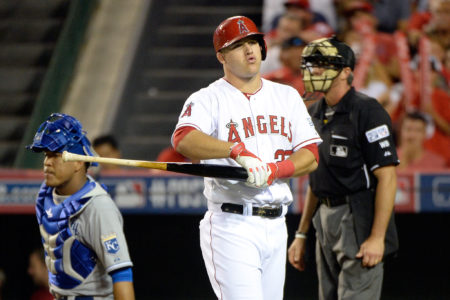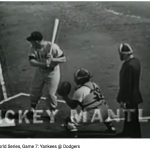There Was Joy in Mudville During the 1980s
 Remember, there’s no joy in Mudville when the mighty Casey strikes out. The fans may even stop attending games if they’re robbed of their one-thousandth of a second of joyful glee when the ball’s smacked anywhere between the foul lines.
Remember, there’s no joy in Mudville when the mighty Casey strikes out. The fans may even stop attending games if they’re robbed of their one-thousandth of a second of joyful glee when the ball’s smacked anywhere between the foul lines.
Strikeouts are an evolving art form that produces the drab, gray boredom of inertia.
Baseballers repeat over and over that the pitcher dictates the game. Pitch selection will determine where the ball should be hit. An outside pitch should be lined into the opposite field, not grounded to the pull field. There’s nothing wrong with a single that starts (or continues) a rally.
Unless the hitter’s hell-bent on hitting a home run and nothing else will suffice.
So, Mike Trout’s in the box. Studying Alex Cobb on the mound, who is fidgeting for eternity before launching his offering. But Trout calls time. The umpire grants it. He steps out.
Can you remember the precise rituals of David Ortiz, Dustin Pedroia and Bernie Williams when they stepped out of the box?
When Cobb finishes fiddling with the resin bag, Trout steps back in, Cobb comes set, and like a rubber band unfolding, an orb uncoils into the air. Before Trout can move the bat off his shoulder the ball whirls past and the umpire growls strike three. Indecision. He couldn’t move the runner over one base.
Kris Bryant thinks he checked his swing, but his lumber has pierced the imaginary plane of home plate. He knows it for sure when the umpire shoots out an arm, thrusts up a knee, and barks strike three.
Chris Carter unleashes a wild, furious arc across home plate so tumultuous it casts a temporary squall. Even the orb avoids his powerful gust before it breaks down and out, off the plate. It looked like a strike one nanosecond before its ungodly bottom dropped out. Carter’s discombobulated, and like mighty Casey, the sneer’s gone from his lip. There’s still a runner on third. Teeth clenched, he heads back to the dugout rueing his swing-and-miss on a pitch he should’ve hammered over the fence.
So, the air’s been shattered by the nth degree of Casey’s hellacious arc. The Mudville nine await in the dugout. He steps on cracked pumpkin seeds. Over tobacco juice stains, and finds solitude at the end of the hard wood of regret where the loneliness of grim melancholy hides.
This is baseball today.
Drag coefficients. Trailing vortices. Statistics. The muscular memory of swings and misses. Umpires dancing behind the plate. The “strike three” call. The new performance art of baseball.
The hard fact is there’ll be more strikeouts than base hits this year in major league baseball.
Why? Because of the invisible elephant on the field. That stack of hundred dollar bills stretching from home plate 410 feet to dead center field. The reward for hitting one over the fence 40 times a year. Every player knows those are stacks out there. That’s why they’re swinging for the fences.
Every at-bat.
That’s also why fewer batters are adjusting/shortening their swings to put the ball in play. Why should they? The invisible elephant does not reward team play. You may get high fives in the dugout, but when it comes to contract negotiations, team management will not only not give you high fives, they may not even give you a contract.
No player is paid home-run hitting money unless they hit a lot of home runs and can at least play acceptable defense.
So, a man like Chris Carter, who led the National League with 41 home runs in 2016, is out of MLB baseball because his strikeouts do not balance his occasional home runs. And Carter’s 3.0 WAR over 12 major league seasons means he offered a .025 WAR per season. No reason to offer a .025 WAR a long-term contract.
Then there’s the fortunate one. Chris Davis. He’s already earning home-run hitter money after 53 and 47 home run seasons, when he signed a $161 million, seven-year contract through 2022. It’s the worst contract in baseball. Baltimore’s stuck with this radioactive contract for a player whose 2018 WAR (so far) is -2.5.
Or what about Joey Gallo, a young player not eligible for arbitration until 2020? Even if he mashes 40 plus home runs the next few years, he strikes out so much, the question is will any team will offer him a beefy salary or a long-term contract?
In contrast, notice Mike Trout’s numbers. Yes, he strikes out, but he’s a winning player with a 62.6 WAR over seven seasons (including this one). That makes him about a 9 WAR player each season in the majors. Worth a lucrative, long-term contract.
Take a look at the career statistics of these payers:
| Player | Career K% | Career WAR | Career OPS |
| Ted Williams | 7.2% | 130.4 | 1.116 |
| Manny Machado | 16.5% | 29.1 | .822 |
| Miguel Cabrera | 17.1% | 70.4 | .946 |
| Mickey Mantle | 17.3% | 112.3 | .977 |
| Bryce Harper | 21.0% | 30.4 | .900 |
| Mike Trout | 21.4% | 62.6 | .987 |
| Kris Bryant | 23.4% | 22.8 | .906 |
| Mark Reynolds | 30.8% | 11.6 | .786 |
| Chris Davis | 32.4% | 14.5 | .795 |
| Chris Carter | 33.3% | 3.0 | .768 |
| Joey Gallo | 37.9% | 5.6 | .815 |
Baseballers know strikeouts kill rallies. And since so many hitters bet everything on one throw of the dice, baseball continually loses when it craps out.
Clutch hitting, moving the runner over, all the little things that win games, go unrewarded financially. And players are aware of what pays off.
Problem is, there’s less correlation between swinging hard and home runs, than mistakes by pitchers. So, most of these strikeouts are unnecessary. If hitters simply mashed the mistakes (the hanging curve balls and sliders and fast balls that linger too long over the middle of the plate) that only require good contact, and shortened up on non-mistake pitches, they would put the ball in play more often, the game would move, there’d be more action, and more runs would score. Bingo.
But, they’d be sacrificing big money.
There was once joy in Mudville when Whitey Herzog managed the go-go St. Louis Cardinals of the mid-1980s. Lots of speed. Great hitting and pitching. Ozzie Smith, Tommy Herr and Willie McGee were on the Mudville nine. And Jack Clark swatted balls over the fence every once in a while, too. Chuck Hiller could barely stay in the third base coaching box he was so busy waving in Cardinal runners barreling around third base.
That’s why there were so many loud, lusty yells in Mudville in the ’80s.

























